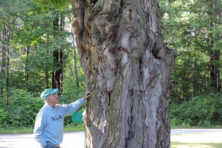Door to Nature: Sugar Maple Tree Sap
- Share
- Tweet
- Pin
- Share

A favorite slogan of mine is, “May is the month for morel mushrooms.” But now I also like “March is the month for maple syrup.”
Friends who live in Sturgeon Bay tap 200 sugar maple (Acer saccharum) trees each year in late winter. The best sap run occurs on sunny days when the temperature rises above 32 degrees, followed by nights that are below freezing. This can be very different each year, so weather patterns play an important role. It also helps to have snow cover, which promotes the cooler conditions for tree roots.
I remember two good friends from years ago, Walter and Bertha Reinhard, who tapped their maple trees and produced syrup for 50 years. They boiled the sap in a large pan over a wood-fired heater in a sugar shack in their woods between Baileys Harbor and Fish Creek.
One cloudy day, my late husband, Roy, and I drove over to visit them. We saw the smoke coming out of the shack’s chimney and knew they were cooking the sap. Bertha invited us in and scooped some partially cooked sap from the big pan. She put it in her tea kettle, dropped in a few tea bags, and soon we were enjoying maple-sap tea.
We were producing a slide program called Reverence for Wood, and Roy decided to photograph the Reinhards collecting sap, cooking it down and then doing the final filtering and bottling in their house. We told them we were going to show the program that summer at the Baileys Harbor Town Hall as part of The Ridges Sanctuary’s Thursday-evening nature series.
Well, Walter and Bertha went to the program and sat in the front row. When the section came showing them doing their maple-syrup work, everyone could hear Bertha laughing out loud, seeing herself and Walter on the big screen.
My friends Max and Deanna have been making maple syrup for many years, and they sell it, along with the honey they collect and bottle, at the farmers market in Sturgeon Bay. I learned that Max’s brother up north in Oneida County taps 4,600 trees on 500 acres. He has a pipeline system that makes it more convenient than emptying the buckets from each tree.
Walter and Bertha used metal pails that hung from the tap at each maple tree. She explained that they painted a broad, red mark on one side of the pail and a different color on the other side. Each day as they began emptying the pails into the collecting tub, they turned the bucket around to the other color so that they could see which trees still had buckets that needed emptying.
Global climate change is affecting the weather all over this planet, and it makes us wonder how long the tapping of maple trees will last. As our winters become warmer and we have more rain than snow, it could alter how much sap can be collected each spring.
There are several other species of maple trees that produce some sweet sap. The black maple (Acer nigrum), found in southern Wisconsin and Michigan, produces a fine grade of “sweet water,” as the Native Americans of the Great Lakes region called it. The sugar maple and black maple are very closely related – so much so that some experts claim the black maple is the same species as our sugar maple.
All the maple species that grow well in this region of Wisconsin can be tapped for their sap and will yield syrup of varying degrees of excellence and sweetness. Even the lowly box elder (Acer negundo), a true maple, can be used, although its syrup lacks the extreme sweetness and flavor of the sugar maple. Canadians refer to the box elder as the Manitoba maple.
The red maple (Acer rubrum) – more commonly found in moist soil and often referred to as the swamp maple – grows large enough to tap (a 10-inch-diameter trunk) and produces a fair grade of syrup.
Another maple tree, which grows in large numbers in many cities, is the Norway maple (Acer platanoides). This fast-growing tree, imported from Europe, establishes a large size, but I’m not sure about its suitability for producing good maple syrup. This tree is not welcomed because it can hybridize with sugar maples, upsetting their genetic purity and threatening their very existence in future years.
Enjoy the sweet water that’s made into syrup on your pancakes and waffles, and encourage the preservation of these marvelous sugar maples in Wisconsin.


